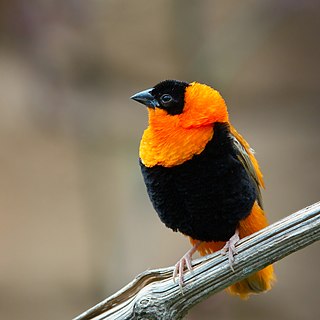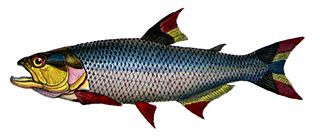
Characiformes is an order of ray-finned fish, comprising the characins and their allies. Grouped in 18 recognized families, more than 2000 different species are described, including the well-known piranha and tetras.

Huntsman spiders, members of the family Sparassidae, catch their prey by hunting rather than in webs. They are also called giant crab spiders because of their size and appearance. Larger species sometimes are referred to as wood spiders, because of their preference for woody places. In southern Africa the genus Palystes are known as rain spiders or lizard-eating spiders. Commonly, they are confused with baboon spiders from the Mygalomorphae infraorder, which are not closely related.

Cassin's finch is a bird in the finch family, Fringillidae. This species and the other "American rosefinches" are placed in the genus Haemorhous.

The northern red bishop or orange bishop is a small passerine bird in the family Ploceidae. It is part of the largest genus in the family with over 60 different species. Its sister species is the Southern red bishop. This species is most recognizable by the bright reddish orange with contrasting black plumage displayed by the breeding male. It is most common throughout the northern African continent but has also been introduced to areas in the western hemisphere.

Agassiz Peak is the second-highest mountain in the U.S. state of Arizona at 12,360 feet (3,767 m). It is located north of Flagstaff, Arizona in the San Francisco Peaks. It is in the Kachina Peaks Wilderness on the Coconino National Forest. The peak was named in honor of Louis Agassiz, a Swiss-born American biologist and geologist.

Salminus brasiliensis, also known as the golden dorado, dorado, river tiger, dourado, or jaw characin is a large, predatory characiform freshwater fish found in central and east-central South America. Despite having Salminus in its name, the dorado is not related to any species of salmon, nor to the saltwater fish also called dorado. It is very popular among recreational anglers and supports large commercial fisheries.

The southern red bishop or red bishop is a small passerine bird belonging to the bishop and widowbird genus Euplectes in the weaver family, the Ploceidae. It is common in wetlands and grassland in Africa south of the Equator. North of the Equator, it is replaced by the northern red bishop or orange bishop which was formerly regarded as a subspecies of this species.

Conus franciscanus, common name the hybrid cone, is a species of sea snail, a marine gastropod mollusk in the family Conidae, the cone snails and their allies.

The white-winged widowbird is a species of passerine bird in the family Ploceidae native to Africa south of the Sahara. It is highly sexually dimorphic in its breeding season, during which the male's yellow plumage turns dark and he gains more white feathers, contrasting with the female's predominantly pale coloration. Three subspecies are recognised.

The black bishop is a species of passerine bird in the family Ploceidae native to Africa south of the Sahara. Three subspecies are recognised.

Salminus, popularly known as dorado or dourado, is a genus of relatively large, predatory freshwater fish from the family Characidae. They are native to large tropical and subtropical rivers in South America, and undertake migrations during the rainy season to spawn. They are very popular among recreational anglers and also support important commercial fisheries.

Kleidocerys is a genus of seed bugs in the family Lygaeidae. There are about 17 described species in Kleidocerys.

Cyclodinus is a genus of antlike flower beetles in the family Anthicidae. There are more than 40 described species in Cyclodinus.
Meloe franciscanus is a species of blister beetle in the family Meloidae. It is found in the deserts of the southwestern United States. The larvae are parasites of bee larvae, eating them and consuming their provisions.
Cyclodinus franciscanus is a species of antlike flower beetle in the family Anthicidae. It is found in North America.
Melanoplus franciscanus, the San Francisco short-wing grasshopper, is a species of spur-throated grasshopper in the family Acrididae. It is found in the American Southwest, in the Guadalupe Mountains of Texas and from the San Mateo Mountains of New Mexico to the San Francisco Peaks of Arizona. .
Ioscytus is a genus of shore bugs in the family Saldidae. There are about seven described species in Ioscytus.

Limnogonus is a genus of water striders in the family Gerridae. There are 28 described species in Limnogonus. Similar to other gerromorphan bugs, most species of Limnogonus have both macropterous wing morphs, which means that they are often able to fly. The wings are thought to be an adaptation to help the insects get away from drought allowing them to fly to the next available area that has water bodies when the rainy season arrives.

Anopheles franciscanus is a species of mosquito in the family Culicidae. This species has been collected in southern California.
Cobalos franciscanus is a species of cutworm or dart moth in the family Noctuidae.















